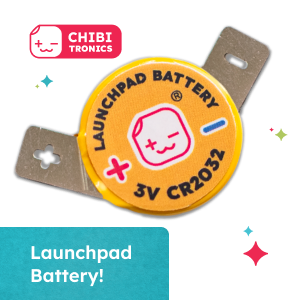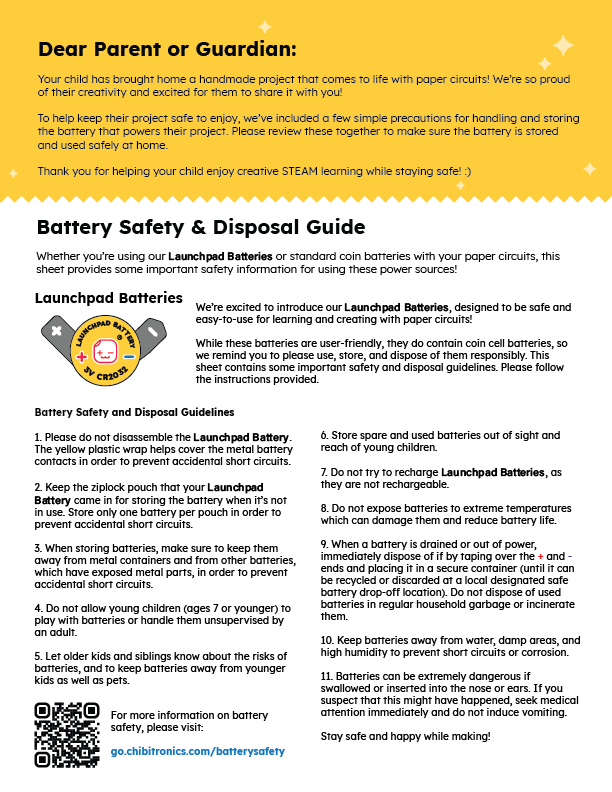Contents
Battery Safety Guidelines
Whether you’re using our Launchpad Batteries or standard coin batteries with your paper circuits, this page provides some important safety information for using these power sources!
About the Launchpad Battery

We’re excited to introduce our new safer, easier-to-use Launchpad Batteries, designed for learning and creating with paper circuits!
Here is some technical information about the Launchpad Battery:
- Chemistry: Non-rechargeable Lithium Metal batteries
- Voltage: 3V
- Safe Usage Temperature: -4°F to 160°F (-20°C to 60°C)
- Energy capacity: 230 mAh
Our Launchpad Batteries are designed for safe, creative learning — but like all coin cell batteries, they need careful handling.
Battery Safety and Disposal Guidelines
- Do not disassemble – The yellow plastic wrap on the Launchpad Battery covers metal contacts to prevent accidental short circuits.
- Store safely – Keep the ziplock pouch that your Launchpad Battery came in for storing the battery when it’s not in use. Store only one battery per pouch in order to prevent accidental short circuits.
- Avoid metal contact – When not in use, keep batteries away from metal containers, binder clips, conductive tape, other batteries, and any exposed metal parts. This is to prevent accidental connections that could drain your battery.
- Keep out of reach of children – Children under 8 should not handle batteries without close adult supervision.
- Educate older kids on safety – Let older kids and siblings know about the risks of batteries, and to keep batteries away from younger kids and pets.
- Store batteries safely away from young children – Store spare and used batteries out of sight and reach of young children.
- Do not recharge – Do not try to recharge Launchpad Batteries, as they are not rechargeable. Attempting to recharge may cause leakage, overheating, or rupture.
- Avoid extreme temperatures – Do not expose batteries to heat sources, direct sunlight for long periods, fire, or freezing temperatures. Doing so can cause leakage, rupture, or reduced battery life.
- Prevent water damage – Keep batteries away from water, damp areas, or high humidity to prevent short circuits or corrosion.
- Proper disposal – When a battery is drained or out of power, immediately dispose of it by taping over the + and – ends and placing it in a secure container (until it can be recycled or discarded at a locally designated safe battery drop-off location). Do not dispose of used batteries in regular household garbage or incinerate them.
- Ingestion hazard – Batteries can be extremely dangerous if swallowed or inserted into the nose or ears. If you suspect that this might have happened, seek medical attention immediately and do not induce vomiting. Have a physician call the NATIONAL BATTERY INGESTION HOTLINE for advice and follow-up: (202) 625-3333 collect day or night.
- Travel safety – When traveling, be sure to keep spare batteries in individual protective pouches or cases to avoid accidental short circuits. Follow airline rules for carrying batteries in hand luggage rather than checked luggage.
Additional Battery Safety & Recycling Resources
United States
- National Battery Ingestion Hotline – https://www.poison.org/battery
- Call2Recycle (battery recycling locations) – https://www.call2recycle.org/
- U.S. Consumer Product Safety Commission – https://www.cpsc.gov/BatterySafety
International
- Battery Safety World – https://www.batterysafetyworld.com/
- Earth911 (global recycling search) – https://earth911.com/
- European Battery Directive & Safety Info – https://ec.europa.eu/environment/topics/waste-and-recycling/batteries-and-accumulators_en
- Battery Safety from Product Safety Australia – https://www.productsafety.gov.au/batteries

Battery Safety Letter PDF
Are you sending home a paper circuit project with your students? Here’s a helpful letter you can include to share important safety tips with families!
General Safety Guidelines for Paper Circuits

Below are some additional safety guidelines when working with paper circuits:
- Ages 8+ – Recommended for children ages 8 and up. Younger children should work under close adult supervision.
- Sharp edges – Copper tape and paper edges may cause cuts. Handle with care.
- No ingestion – Keep all components away from mouth, eyes, and nose.
- Avoid AC power – Do not place conductive tape or components near electrical outlets or plugs
- Keep dry – Avoid water or wet areas when making paper circuits. Moisture can create unintended connections that may damage the battery or circuit components.
